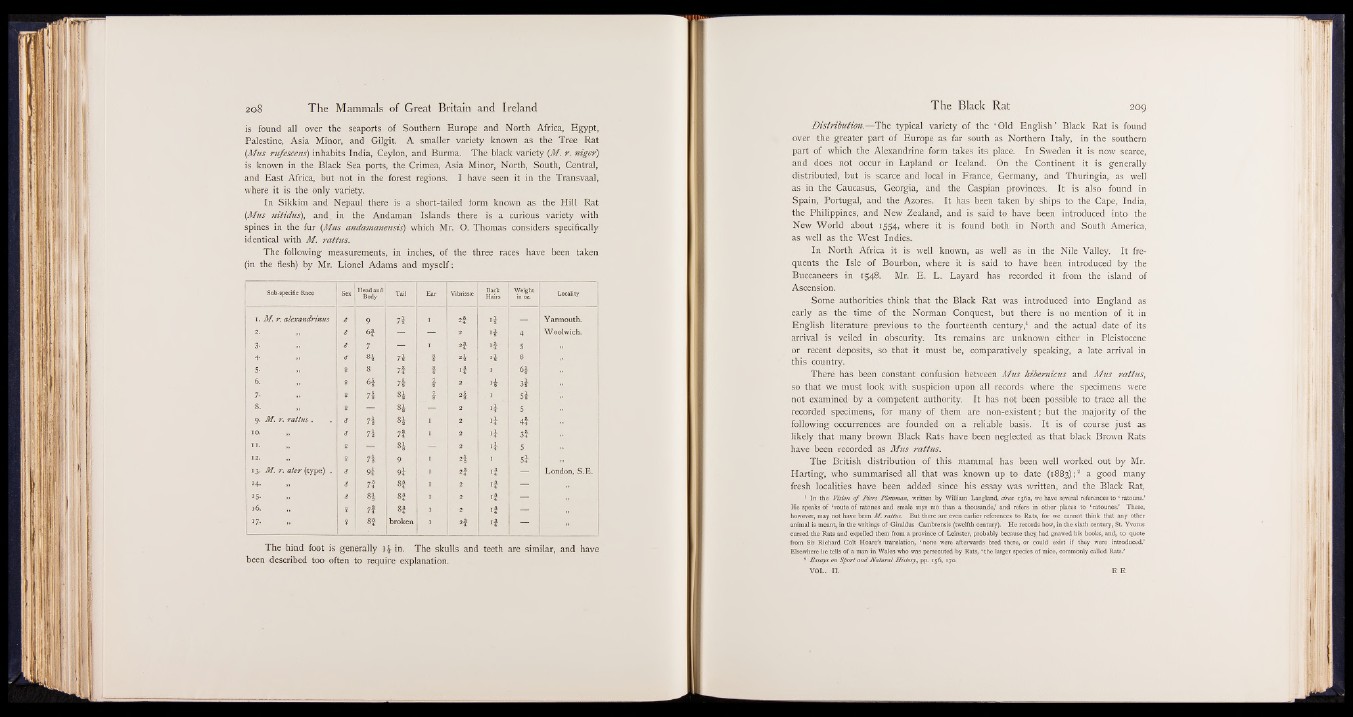
is found all over the seaports of Southern Europe and North Africa, Egypt,
Palestine, Asia Minor, and Gilgit. A smaller variety known as the Tree Rat
{Mus rufescens) inhabits India, Ceylon, and Burma. The black variety {M. r. niger)
is known in the Black Sea ports, the Crimea, Asia Minor, North, South, Central,
and East Africa, but not in the forest regions. I have seen it in the Transvaal,
where it is the only variety.
In Sikkim and Nepaul there is a short-tailed form known as the Hill Rat
(Mus nitidus), and, in the Andaman Islands there is a curious variety with
spines in thé fur {Mus andamanensis) which Mr. O. Thomas considers specifically
identical with M. rattus.
The following measurements, in inches, of the three races have been taken
(in the flesh) by Mr. Lionel Adams and myself:
Sub-specific Race Sex Head and
Body Tail Ear Vibrissa; Back
Hairs
Weight Locality
I. M. r. alexandrinus 8 • 9 7\ I 24 Yarmouth.
2 jjjB | 8 6f — — 2 1$ 4 Woolwich.
3- & 7 — I 2f i f 5
4- 8 8i 7i 4 *4 ■4 8
5- 9 8 7f - f ■ f I «4
6. „ 9 7t i 2 ■ i Ü
7- 9 74 «4 Ï I 54
8. 9 H — 2 ■4 5
9. M. r. rattus . 8 7% H I 2 ■4 4Ï
10. % 8 7i 7t I 2 ■4 3f
1SB „ 9 — «4 2 5
12. „ 9 7\ 9 i *4 I
13. M. r. ater (type) . 9\ 9i i 2f If London, S.E.
n 8 7f 8f I 2 i f — „
j H 8 H 8f I 2 i f — „
16. „ 9 7i 8f I 2 I& — „
17- 9 8f broken I 2f jS.
The hind foot is generally in. The skulls and teeth are similar, and have
been described too often to require explanation.
D istribution.—The typical variety of the ‘ Old English’ Black Rat is found
over the greater part of Europe as far south as Northern Italy, in the southern
part of which the Alexandrine form takes its place. In Sweden it is now scarce,
and does not occur in Lapland or Iceland, On the Continent it is generally
distributed, but is scarce and local in France, Germany, and Thuringia, as well
as in the Caucasus, Georgia, and the Caspian provinces. It is also found in
Spain, Portugal, and the Azores. It has been taken by ships to the Cape, India,
the Philippines, and New Zealand, and is said to have been introduced into the
New World about 1554, where it is found both in North and South America,
as well as the West Indies. .
In North Africa it is well known, as well as in the Nile Valley. It frequents
the Isle of Bourbon, where it is said to have been introduced by the
Buccaneers in 1548. Mr. E. L. Layard has recorded it from the island of
Ascension.
Some authorities think that the Black Rat was introduced into England as
early as the time of the Norman Conquest, but there is no mention of it in
English literature previous to the fourteenth century,1 and the actual date of its
arrival is veiled in obscurity. Its remains are unknown either in Pleistocene
or recent deposits, so that it must be, comparatively speaking, a late arrival in
this country.
There has been constant confusion between Mus hibemicus and Mus rattus,
so that we must look with suspicion upon all records where the specimens were
not examined by a competent authority. It has not been possible to trace all the
recorded specimens, for many of them are non-existent; but the majority of the
following occurrences are founded on a reliable basis. It is of course just as
likely that many brown Black Rats have been neglected as that black Brown Rats
have been recorded as Mus rattus.
The British distribution of this mammal has been well worked out by Mr.
Harting, who summarised all that was known up to date (1883);2 a good many
fresh localities have been added since his essay was written, and the Black Rat,
1 In the Vision o f Piers Plowman, written by William Langland, circa 1362, we have several references to ‘ ratouns.’
He speaks of ‘ route of ratones and smale mys mo than a thousande,’ and refers in other places to ‘ ratounes.’ These,
however, may not have been M. rattus. But there are even earlier references to Rats, for we cannot think that any other
animal is meant, in the writings of Giraldus Cambrensis (twelfth century). He records how, in the sixth century, St. Yvorus
cursed the Rats and expelled them from a province of Leinster, probably because they had gnawed his books, and, to quote
from Sir Richard Colt Hoare’s translation, ‘ none were afterwards bred there, or could exist if they were introduced.’
Elsewhere he tells of a man in Wales who was persecuted by Rats, ‘ the larger species of mice, commonly called Rats.’
1 Essays on Sport and Natural History, pp. 156, 170.